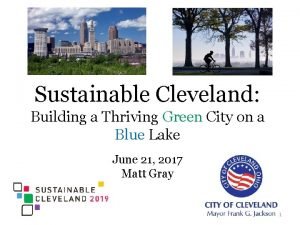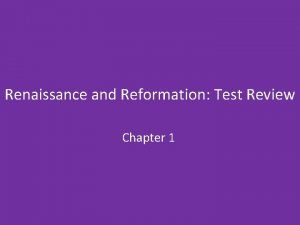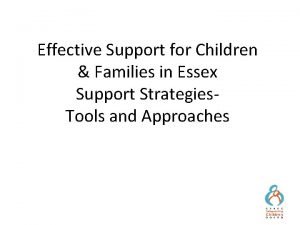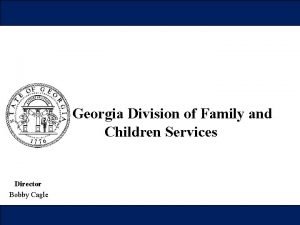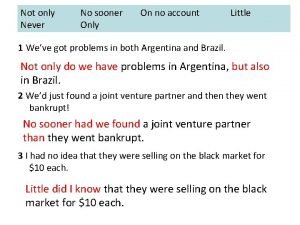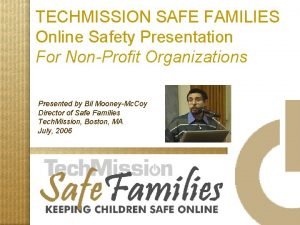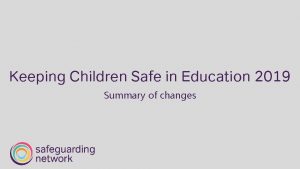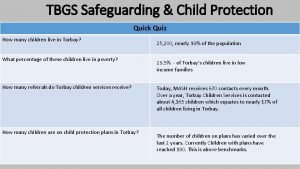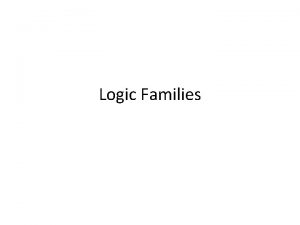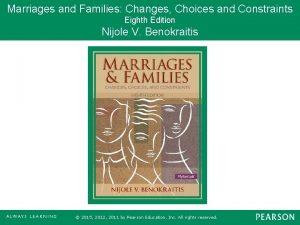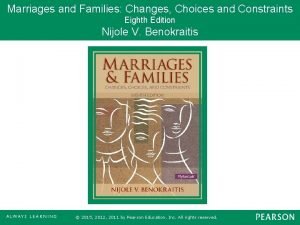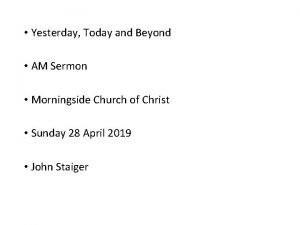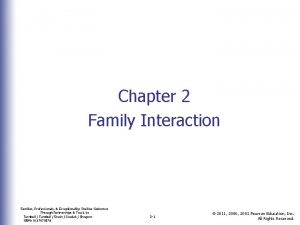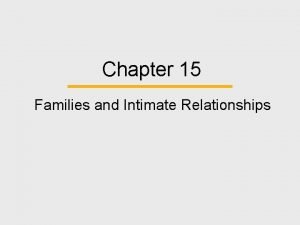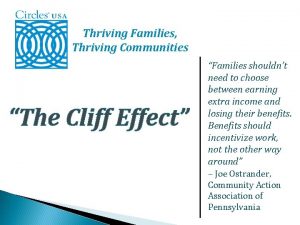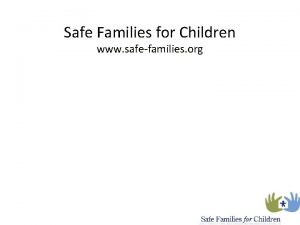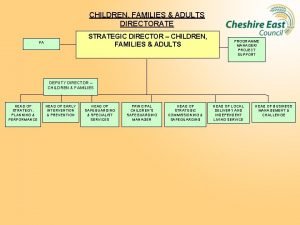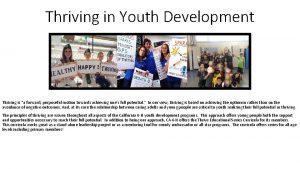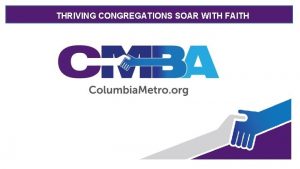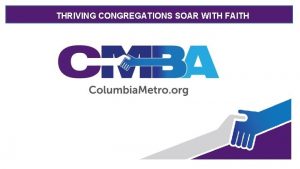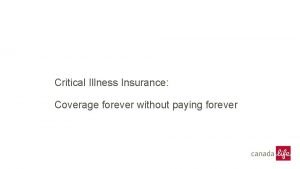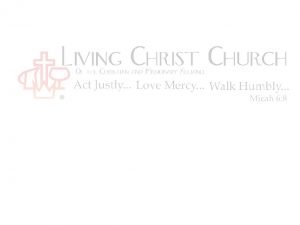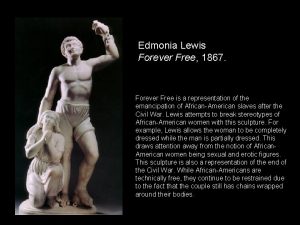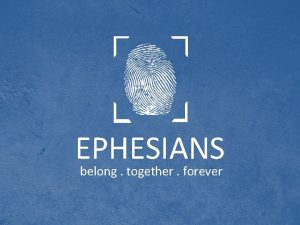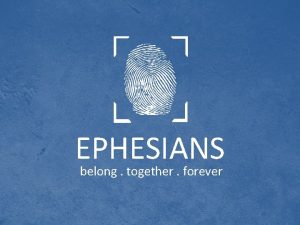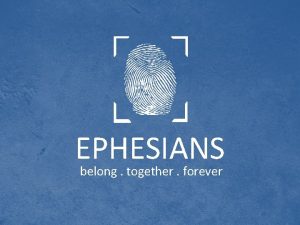CHILDREN SAFE AND THRIVING WITH FOREVER FAMILIES SOONER








































- Slides: 40

CHILDREN SAFE AND THRIVING WITH FOREVER FAMILIES, SOONER DIVISION OF FAMILY & CHILDREN SERVICES Isabel Blanco, Deputy Director of Field Operations September 25 th, 2009 1

ADOPTION & SAFE FAMILIES ACT (ASFA) OF 1997 National legislation which has been embedded in Georgia state statutes. Two Overarching Goals: n Change the experience of children who are entering the child welfare system. n Move children to permanency. 2

ASFA PHILSOPHIES n The safety of children is the paramount concern that must guide all child welfare services. n Foster care is a temporary setting and not a place for children to grow up. n Permanency planning efforts should begin as soon as a child enters the child welfare system. n The child welfare system must focus on results and accountability. n Innovative approaches are needed to achieve the goals of safety, permanency and well-being. 3

Introduced Shorter Time Limits For Making Decisions About Permanent Placements n Permanency hearings to be held no later than 12 months after entering foster care. n States must initiate termination of parental rights proceedings after the child has been in foster care 15 of the previous 22 months, except if not in the best interest of the child, or if the child is in the care of a relative. 4

Forever Families Sooner n Required States to initiate court proceedings to free a child for adoption once that child had been waiting in foster care for at least 15 of the most recent 22 months, unless there is an exception. n Allowed children to be freed for adoption more quickly in extreme cases. 5

Health and Safety n Ensured health and safety concerns are addressed when a State determines placement for abused and neglected children. n Required HHS to report on the scope of substance abuse in the child welfare population, and the outcomes of services provided to that population. 6

Increased accountability n Required States to increase documentation of child-specific efforts to move children into permanency. n Required HHS to establish new outcome measures to monitor and improve State performance 7

ASFA LEADS TO CHILD & FAMILY SERVICES REVIEW: RESULTS-ORIENTED APPROACH On January 25, 2000, the Federal Department of Health and Human Services issued regulations for ASFA establishing the Child and Family Services Review (CFSR). The review covers child welfare services funded under Titles IV -B and IV-E of the Social Security Act including: n n Child Protective Services, Foster Care, Adoption, and Family Preservation and Support Services. Georgia received $9. 4 million in IV-B and $79. 4 million in IV-E in SFY 2007. 8

In this review process, Georgia is: Assessed for "substantial conformity" (95%) on a wide range of outcomes and administrative systems. n Required to develop Program Improvement Plans (PIP) in response to identified areas in which "substantial conformity" is not achieved. n Subject to significant penalties if improvements are not made. 9

PERFORMANCE OUTCOMES SAFETY Protection from abuse and neglect Safely remain in own home whenever possible and appropriate PERMANENCY Permanent and stable living arrangements Continuous family relationships and connections WELL-BEING Enhanced capacity of the family to provide for child’s needs Child’s educational needs are met Child’s physical and mental health needs are met 10

OUTCOMES FOR CHILDREN & FAMILIES Outcomes are measured using two methods: n Onsite review of selected cases (65 cases statewide in last review and stakeholder interviews). n Statewide performance measures computed with data submitted from Georgia's information systems. 11

Outcome Median Percentage of Cases Rated as Substantially Achieved Across States 2001 -2004 Range of Percentage of Cases Rated as Substantially Achieved Across States 2001 -2004 Georgia Percentage of Cases – Substantially Achieved – 2001 Georgia Percentage of Cases – Substantially Achieved - 2007 Safety Outcome 1: Children are first and foremost, protected from abuse and neglect 85. 8 62. 0 -100 90 72 Safety Outcome 2: Children are safely maintained in their homes when possible and appropriate 80. 8 48. 0 -93. 5 77. 5 68 Permanency Outcome 1: Children have permanency and stability in their living situations 50. 9 7. 1 -92. 0 71. 42 43 Permanency Outcome 2: The continuity of family relationships and connections is preserved 77. 3 37. 9 -94. 3 75 44 Well-Being Outcome 1: Families have enhanced capacity to provide for children’s needs 60. 0 18. 0 -86. 0 72 35 Well-Being Outcome 2: Children received services to meet their educational needs 83. 0 64. 7 -100 75. 7 78 Well-Being Outcome 3: Children receive services to meet their physical and mental health needs 69. 9 51. 2 -92. 1 63. 2 68 12

GEORGIA’S 2007 CFSR PROGRAM IMPROVEMENT PLAN (PIP)

Proposed PIP Structure Approach n Crosscutting Strategies ¨ Utilize crosscutting strategies to effectively improve multiple outcomes n Build upon existing initiatives n n n Family Resource Connections (Joint use of OFI/Social Services resources as a Diversion Resource) Family Team Meetings LOC Unbundling Initiative for Support and Retention for Foster Families (EMBRACE) Outstanding Paternal Involvement (The early identification and engagement of fathers and paternal families within the services case) 14

Program Improvement Plan v Four Crosscutting Strategies v 111 v Action Steps Incremental Improvements set for 9 outcome measure/items Items 1, 3, 4, 7, 10. 17, 18, 19, 20 15

Item 1 Timeliness of initiation of Investigation 3 Services to protect child in the home and prevent removal or re-entry into foster care 4 Risk Assessment and Safety Management 7 Permanency Goal for the child 10 Other Planned Permanent Living Arrangement 17 Needs and Services of child, parents and foster parents 18 Child and family involvement in case planning 19 Caseworker visits with child 20 Caseworker visits with parents Proposed Improvement 08/31/09 PEAS Data Current Gap 81% 80. 47% -. 53% 78. 9% 78. 83% 73. 5% 72. 82% 46. 42% 48. 82% Trending down 79. 95% 76. 81% Trending down 58. 94% 58. 51% Trending down 51. 09% 57. 21% 60. 73% 68. 63% 21. 01% Standard Met 3 rd qtr -. 68% Standard Met 3 rd qtr -3. 14% Standard Met 3 rd qtr Standard Met 4 th qtr Standard Met 3 rd qtr -1. 99% 16

Agency must also demonstrate incremental improvements in 2 of the National Standards as determined by NCANDS and AFCARS data National Standard Safety Outcome 2: Absence of child abuse Neglect in foster care Permanency 2: Timeliness of adoption 99. 68 106. 4 or higher Neg. level of Improvement Current State Score 98. 6986 98. 6 (2008) 99. 3 101. 9 (03/31/09 08 B 09 A) 17

Georgia Data Program Improvement Scores and Composite Scores PEAS data as of 08/31/09 Composite Data received from ACF on April 01, 2008 through March 31, 2009

Safety 2 Safety Data: Absence of child abuse/neglect in foster care National Standard FFY 2006 FFY 2007 FFY 2008 Negotiated Improvement Goal 99. 68% 99. 22% 98. 85% 98. 6986 Current Performanc e 19

Permanency Composite 2 Permanency Outcome 2: Timeliness of adoption State ranked 21 of 47 National Standard 106. 4 FFY 2007 B 2008 A FFY 2008 AB FFY 2008 B 2009 A Negotiated Improvement Goal 105. 2 103. 2 99. 3 106. 0779 Current Performance 20

Component Weight State Score 75 th Percentile 26% 26. 9% 36. 6%% 18% 33. 2 months (25 th percentile) 27. 3 months Lower score is preferable Of children in care for 17 months or more at the start of the reporting year, % who exit to adoption by the end of the year 22% 26% 22. 7% Of children in care 17 months or longer and not legally free for adoption at the start of the reporting year, % who become legally free within 6 months of the start of the year. 19% 7. 8% 10. 9% Of children who are legally free for adoption in the previous year, % adopted in less than 12 months of becoming legally free. 15% 51% 53. 7% Of children exiting to adoption, % exiting in less than 24 months of current removal date Of children exiting to adoption, median number of months in foster care 21

22

23

24

25

26

27

28

29

30

31

CHILD WELFARE TRENDS 2007 - 2008

RECURRENCE OF MALTREATMENT January 2008 – January 2009 National Standard= 5. 4% 33

FOSTER CARE ENTRIES 2007 -2008 The number of children entering foster care was significantly higher from January through June 2007 than in same period in 2008. However, sine July, that gap has been closing. More children entered care in October 2008 than in October 2007. 34

FOSTER CARE EXITS 2007 -2008 35

FOSTER CARE RE-ENTRY January 2007 – December 2008 National standard: less than or equal to 8. 60% Definition: Of all the children who entered, the percentage that were discharged from a previous placement within 12 months of the current placement. . 36

NUMBER OF FINALIZED ADOPTIONS SFY 2008, SFY 2009 EXPECTED & SFY 2009 ACTUAL Note: Expected based on finalizing at least half of total adoptions done in SFY 2008. 37

ADOPTION INFORMATION BY NUMBER OF MONTHS SFY 2007, SFY 2008 & SFY 2009 Note: Data for SFY 2009, as of December 31, 2008. 38

AVERAGE NUMBER OF MONTHS FROM ENTRY TO FIRST TPR SFY 2007 – SFY 2009 39

AVERAGE NUMBER OF MONTHS FROM ENTRY TO ADOPTION SFY 2007 – SFY 2009 40
 Forever you are faithful forever you are strong
Forever you are faithful forever you are strong Families can be together forever song
Families can be together forever song Vital villages thriving towns introduction
Vital villages thriving towns introduction Thriving green
Thriving green Renaissance and reformation review
Renaissance and reformation review Financial foundations for thriving communities
Financial foundations for thriving communities Big families vs small families
Big families vs small families The university of oklahoma colors cream
The university of oklahoma colors cream Effective support for children and families in essex
Effective support for children and families in essex Georgia department of children and families
Georgia department of children and families No sooner were the audio tapes leaked
No sooner were the audio tapes leaked No sooner had the reverberation of my blows syntax
No sooner had the reverberation of my blows syntax Sooner textbooks
Sooner textbooks Expressing preference would rather
Expressing preference would rather Dear ben thanks for your letter
Dear ben thanks for your letter Safe families database
Safe families database Safe feed safe food
Safe feed safe food Safe people safe places
Safe people safe places Keeping children safe in education 2019
Keeping children safe in education 2019 Ted safeguarding
Ted safeguarding Comparison of logic families table
Comparison of logic families table Compare and contrast the bach and marsalis families
Compare and contrast the bach and marsalis families Compare and contrast the bach and marsalis families
Compare and contrast the bach and marsalis families Family of orientation
Family of orientation Marriages and families changes choices and constraints
Marriages and families changes choices and constraints Farewell to love poem
Farewell to love poem Lord your mercy endureth forever
Lord your mercy endureth forever You are good and your love endures
You are good and your love endures Long walk to forever analysis
Long walk to forever analysis Endpoint of an angle
Endpoint of an angle Same today tomorrow and forever
Same today tomorrow and forever Success will come and go but integrity is forever
Success will come and go but integrity is forever All glory to god
All glory to god Types of god's glory
Types of god's glory Forever and ever amen
Forever and ever amen Listen to god and live forever
Listen to god and live forever Israel you are good
Israel you are good Yesterday, today and forever sermon
Yesterday, today and forever sermon Britney
Britney Families professionals and exceptionality
Families professionals and exceptionality Family of orientation
Family of orientation



